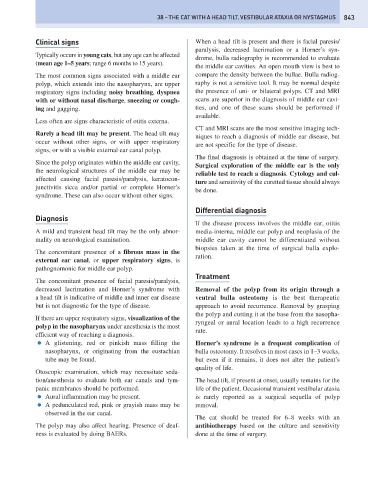Page 851 - Problem-Based Feline Medicine
P. 851
38 – THE CAT WITH A HEAD TILT, VESTIBULAR ATAXIA OR NYSTAGMUS 843
Clinical signs When a head tilt is present and there is facial paresis/
paralysis, decreased lacrimation or a Horner’s syn-
Typically occurs in young cats, but any age can be affected
drome, bulla radiography is recommended to evaluate
(mean age 1–5 years; range 6 months to 15 years).
the middle ear cavities. An open mouth view is best to
The most common signs associated with a middle ear compare the density between the bullae. Bulla radiog-
polyp, which extends into the nasopharynx, are upper raphy is not a sensitive tool. It may be normal despite
respiratory signs including noisy breathing, dyspnea the presence of uni- or bilateral polyps. CT and MRI
with or without nasal discharge, sneezing or cough- scans are superior in the diagnosis of middle ear cavi-
ing and gagging. ties, and one of these scans should be performed if
available.
Less often are signs characteristic of otitis externa.
CT and MRI scans are the most sensitive imaging tech-
Rarely a head tilt may be present. The head tilt may
niques to reach a diagnosis of middle ear disease, but
occur without other signs, or with upper respiratory
are not specific for the type of disease.
signs, or with a visible external ear canal polyp.
The final diagnosis is obtained at the time of surgery.
Since the polyp originates within the middle ear cavity,
Surgical exploration of the middle ear is the only
the neurological structures of the middle ear may be
reliable test to reach a diagnosis. Cytology and cul-
affected causing facial paresis/paralysis, keratocon-
ture and sensitivity of the curetted tissue should always
junctivitis sicca and/or partial or complete Horner’s
be done.
syndrome. These can also occur without other signs.
Differential diagnosis
Diagnosis
If the disease process involves the middle ear, otitis
A mild and transient head tilt may be the only abnor- media-interna, middle ear polyp and neoplasia of the
mality on neurological examination. middle ear cavity cannot be differentiated without
biopsies taken at the time of surgical bulla explo-
The concomitant presence of a fibrous mass in the
ration.
external ear canal, or upper respiratory signs, is
pathognomonic for middle ear polyp.
Treatment
The concomitant presence of facial paresis/paralysis,
decreased lacrimation and Horner’s syndrome with Removal of the polyp from its origin through a
a head tilt is indicative of middle and inner ear disease ventral bulla osteotomy is the best therapeutic
but is not diagnostic for the type of disease. approach to avoid recurrence. Removal by grasping
the polyp and cutting it at the base from the nasopha-
If there are upper respiratory signs, visualization of the
ryngeal or aural location leads to a high recurrence
polyp in the nasopharynx under anesthesia is the most
rate.
efficient way of reaching a diagnosis.
● A glistening, red or pinkish mass filling the Horner’s syndrome is a frequent complication of
nasopharynx, or originating from the eustachian bulla osteotomy. It resolves in most cases in 1–3 weeks,
tube may be found. but even if it remains, it does not alter the patient’s
quality of life.
Otoscopic examination, which may necessitate seda-
tion/anesthesia to evaluate both ear canals and tym- The head tilt, if present at onset, usually remains for the
panic membranes should be performed. life of the patient. Occasional transient vestibular ataxia
● Aural inflammation may be present. is rarely reported as a surgical sequella of polyp
● A pedunculated red, pink or grayish mass may be removal.
observed in the ear canal.
The cat should be treated for 6–8 weeks with an
The polyp may also affect hearing. Presence of deaf- antibiotherapy based on the culture and sensitivity
ness is evaluated by doing BAERs. done at the time of surgery.

